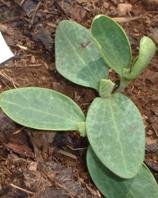





![]() Where can I plant them?
Where can I plant them?
Grow pumpkins in a nice, warm, sunny spot. Pumpkins grow from seeds you plant in late spring, on a vine that grows for the summer and dies when frost hits. (Even a "bush" pumpkin grows on an annual vine.) Planting guides might tell you how far apart to plant in rows, and how many feet between rows. That's for real farmers! You just want to grow a few pumpkins for decoration and fun. That'll take one "hill" of several vines. Imagine you lay down in the garden, wave your arms and legs, and make a compost angel*- that about how much space is needed for a hill of pumpkins. Small pumpkins and bush pumpkins might be squeezed into a little smaller spot. (Giant monster pumpkins need a lot more room and a lot more special care. I'd put them in the advanced category.) One decent pumpkin vine can be cultivated in a really big pot, with good care and room for the growing vine to sprawl. It'll still need the basics of good soil, sun, and ample water.
![]() Do I need special soil?
Do I need special soil?
Most any dirt will do, but pumpkins do really like a rich soil. If you are planning this fall for next year's pumpkin hill, you can pick a spot and prepare it early. Pumpkins like a lot of organic material in the soil. Any compost, old manure, rotten leaves or kitchen waste you can bury in the ground under where you'll plant the pumpkins will be appreciated. You can even plant them right on the top of last year's compost heap.
![]() Where can I get seeds?
Where can I get seeds?
Seed packet displays are an "annual crop" in a lot of stores. They typically include at least one choice of pumpkin. You'll probably find seeds for a medium size orange pumpkin and maybe one other unusual choice, like a miniature or a white-skinned pumpkin. or even a miniature AND white one. (Those white ones are just a different strain, selected for the skin color.) Seed companies sell lots more varieties of pumpkin seeds, if you want to choose the very best one for pie, or edible seeds, or a smooth, carve-able shape. Suppose you have a pile of mush out by the compost heap, where last year's field-grown Halloween pumpkin disintegrated. Volunteer baby pumpkin vines will probably come up right there. Can you use those? Although variations can occur, it's a fair bet that whatever grows there will make a fruit pretty similar to what it came from.
![]() When will I plant them?
When will I plant them?
Plant when the dirt is warm. Seed packets often have a little chart to help you know when the time is right. Make pumpkins one of the last things you plant in the vegetable garden, even after tomatoes. Memorial Day through June is a good time for planting pumpkin seeds in the garden for most U.S. gardeners.

![]() How do I plant and care for them?
How do I plant and care for them?
Plant five or six seeds a good inch down in your chosen spot. Look for big juicy sprouts with oval fleshy green seed leaves in about a week. Keep the biggest three or four sprouts and cut off the weaklings. Soon, the vine starts growing with huge, sort of prickly, leaves. The first flowers you see will be males, without fruit. Later you'll find female flowers with tiny green baby fruits at the base. If all goes well with "the birds and the bees", a female flower will make big green pumpkin. It doesn't turn orange (or white) until it's reached full size.
Think of a good sized pumpkin as a big energy storehouse for the several hundred seeds it'll have inside. The plant will do the work storing that energy if you provide its raw materials. While the vines are growing, give them fertilizer (unless you've really prepared well with organic matter beforehand) and plenty of water. The vines want to spread across the ground and will be happiest if you let them do that. Redirect the tips, if you must, but leave the vines on the ground. Covering them with extra soil or mulch can be a boost for the plant.
![]() Will it get bugs?
Will it get bugs?
There are some insects that like pumpkins as much as you do. If squash bugs find your pumpkin patch, they can be a real challenge. Cucumber beetles like to suck on pumpkin leaves too. Squash vine borers also bore pumpkin vines, but they prefer summer squash. Aphids can attack. (Now pumpkins are sounding like a problem plant!) While these things can attack, pumpkins have tough stems that help them resist insects. The best defense is... well, you know. Take a moment as you water, at least weekly, to look for bugs and remove them or spray them. Be sure to lift any sick leaves to look for critters hiding underneath.
![]() When's it ready?
When's it ready?
When the pumpkin has fully colored, it's ready. Carve, paint, cook, enter in the county fair--the choice is yours, but I expect you'll have at least one nice pumpkin per vine that you've tended. Once you've picked your pumpkins, the vine is done. It can be composted, although if you've had any bug problems, it is wise to burn or bag and discard the old vines.
(Now you may want to go back and read the previous articles in this Pumpkin Week series)
Enjoy!![]()
?* Regional slang reference to snow angels. "Snow angels" are made by laying on your back in the snow and waving arms and legs to make wings and a skirt.
References and credits
Ambler, Wayne, et al. Treasury of Gardening. Lincolnwood, Publications International, 1998?
Copyright © www.100flowers.win Botanic Garden All Rights Reserved